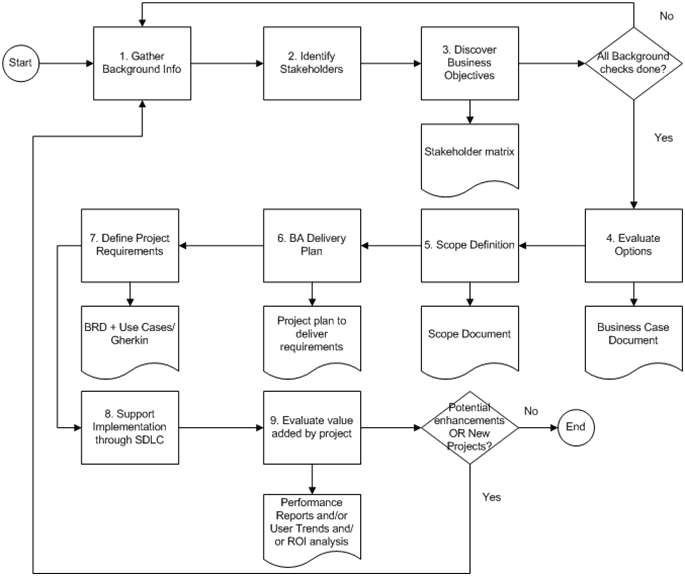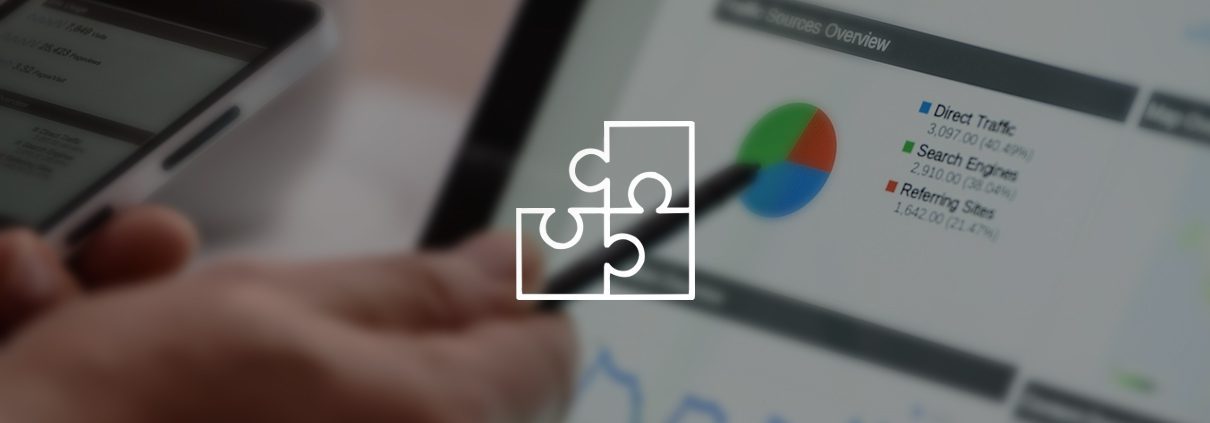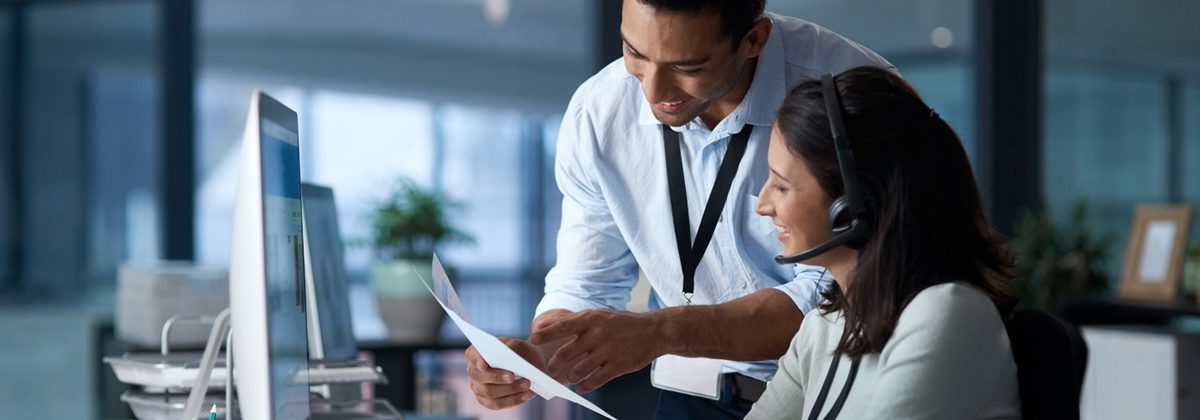By Thejasree Prakash
Business analysis process flow is a systematic approach that identifies, assesses, and improves the processes that drive business outcomes. It can be used in any business function such as customer service, software development, finance etc.
Before a project begins, it is important to begin with the business analysis phase. The process is generally divided into multiple steps with each step involving specific tasks to perform, principles to follow, and documents to produce.
While these steps and principles are agnostic to the business function or domain, the frequency of occurrence or the order may change. Each step within the business analysis phase may be longer or shorter depending on the type of project.
This diagram depicts the business analysis process flow for a software project:
Business Analysis Process Flow Diagram

Step 1: Gather Background Information
This first step is where much of the groundwork for a project is covered. Whether a project is brand new or existing, it’s crucial for the business analyst to gather a significant amount of background information on the project. These are the conditions of the project that need to be determined at this stage:
- What domain is the project under? (financial, health, energy, hosting, etc.) Is there enough information corresponding to the domain? If the answer is no, a business analyst would perform additional research about the project. The analyst would also learn to understand the dos and don’ts and terminologies of the corresponding domain.
- What function is the project under? (HR, finance, operations, sales, customer care, etc.) If the team lacks functional knowledge, then the business analyst needs to collect relevant information that can impact the project’s outcomes.
- Determine the various circumstances that could potentially affect the business strategy for the project. This can be accomplished by using a PESTLE Analysis or Porter’s Five Forces framework.
- PESTLE Analysis: this technique of analysis examines the impact of external forces, such as Political, Economic, Socio-cultural, Technological, Legal, Ethical, and the implications on an organization that has the potential to impact the project and strategy.
- Porter’s Five Forces framework: based on the idea that an organization operates in this technique, this determines the pressures on an organization that may impact the project. Industry competitors, new entrants, substitutes, buyers, and suppliers are examined to determine what, if any, external pressures exist.
Understanding the history of a project and documenting it thoroughly allows the gathering requirement process to flow well. If there are any existing systems that need to interact with business processes or be accounted for, they need to be understood and documented during this stage of the project. Identifying the primary cause of problems with the process and systems help in designing improvements to the process.
Optional documents that are beneficial at this step are:
- Glossary of Terms
- System and Process Records
The Business Analysis Process flow sets the tone for the entire development project, so it’s crucial to flesh it out as much as possible. #bpo
Click To Tweet
Step 2: Identify Stakeholders
The stakeholders on a project are the ones who make decisions and sign off on requirements and priorities. Therefore, identifying all of the stakeholders early on is important.
You can use a stakeholder wheel technique, which contains each stakeholder that impacts the project, such as:
- Owners: shareholders, trustees, or anyone who is sponsoring the project
- Managers: senior or middle managers responsible for communication and monitoring the progress
- Employees: developers, analysts, or testers responsible for delivering the project
- Regulators: any regulators involved that monitor adherence to rules — e.g. a regulator that monitors HIPAA compliance
- Suppliers: any API provider or other supplier service needed that the project might need
- Partners: individuals responsible for working alongside the project that provides complementary or supplementary products or services
- Customers: the end-users of the product
- Competitors: a potential section of users of competitive products or inputs from the competitors themselves
The document at this stage is the stakeholder Matrix, a list of groups and stakeholders for each classification.
Step 3: Discover Business Objectives
Establishing the business strategy and objectives and putting them on paper will help the business analyst and project managers stay focused on the vision and make course corrections along the way. It will also help during scope definition.
It’s important to note that business objectives can vary widely depending on the type of the project. For example, the objectives of implementing an ERP system are very different from the objectives of outsourcing customer service.
- Before getting too deep into the project, ask why the project is needed helps narrow down the business objectives.
A few techniques to assist in establishing business objectives for a project are:
- Benchmarking: understanding competitors and peers who work on the same level; Ansoff’s Matrix can be used for this
- SWOT Analysis: determine the strengths and weakness
- Focus groups and brainstorming
- Documenting and conveying business objectives to all stakeholders, ensuring a single vision
- Making business objectives SMART:
- Specific: describes an outcome that is visible
- Measurable: the outcome should be measurable
- Achievable: objective needs to be feasible to achieve
- Relevant: needs to be in alignment with the company’s vision statement
- Time-bound: can be within a defined time frame
The document at this stage is the Business Objectives List.
Step 4: Evaluate Options
To achieve the objective, it’s important to determine the critical path among the various options available. Here are the steps involved in determining the best path:
- Identify options — brainstorming and focus group meetings help determine various options.
Possible options include:
- Customize/enhance an existing solution to achieve the business objective
- Purchase an existing service/system
- Build a product from scratch
- Integrate to other systems to achieve quickly to market times
- Shortlist options: narrowing down possibilities from a big list to a shortlist of viable options
A few factors to consider while narrowing this down are:
- Feasibility
- Budget/funds available
- Acceptable return on investment
- Business case
A business analyst can prepare a business case based on the narrowed down options, using:
- Cost-benefit analysis: looks at cost of pursuing an action and the benefits of that action
- Impact analysis: identifying and presenting actions that affect the project or company that would factor into pursuing an action
- Risk analysis: various risks that can be involved in pursuing an action
The next step is to present the business case options to stakeholders and have them make a decision.
The document produced during this stage is a Business Case Document.
Step 5: Scope Definition
Based on the objective of the project and a team discussion, this step is when the scope is defined. A list of project development goals is detailed, along with a list of items that are not included in the project. The scope definition document can include:
- Development items in scope
- Development items out of scope
- Integrations in scope
- Integrations out of scope
The document produced in this stage is a Scope Definition Document.
Step 6: Business Analyst Delivery Plan
The business analyst and project owner will provide a detailed timeline for delivering the requirements to the development team. A timeline for the requirements will be provided based on factors such as:
- Stakeholders and their availability
- Project scope
- Project methodology
By dividing requirements into deliverables and providing realistic dates for each of them, this will help plan resources and project timelines accordingly.
The document produced here is the Business Analyst Delivery Plan.
Step 7: Define Project Requirements
This step requires the business analyst to clarify requirements to the business owner and get the OK to deliver them to the development team. Requirements can be divided into functional and non-functional.
Non-functional requirements can be documented in a business requirement document that covers performance, scalability, and security. Functional requirements are provided in terms of use cases, storyboards, prototypes, and wireframes.
A few techniques that help the requirement gathering phase are:
- Interviewing the stakeholders: Ask when, how, where, and what is supposed to be achieved by the user helps arrive at requirements
- Requirements defining techniques: Use case templates, storyboards, prototypes, or wireframes
Based on the development method, requirements can all be delivered upfront, e.g. the waterfall technique. Most development companies shy away from waterfall because it’s difficult to accommodate changes along the way. It’s also not suited for mobile application development. For agile projects, requirements can be delivered per sprint cycle. A business analyst will sequence deliverables to facilitate development plans. You can learn more about waterfall vs. agile here.
Documents required in this stage are 1) Non-functional Requirements business requirement document, 2) Functional Requirements, use cases.
Step 8: Support Implementation Through SDLC
A business analyst is involved in the technical implementation of requirements to ensure that everything aligns.
There are a few steps during this phase:
- Reviewing the technical deliverables to align with requirements
- Based on feedback from the development team, update or repackage requirements to facilitate implementation
- Engage with quality analysts to ensure requirements are tested and requirements are understood
- Manage changes from the business owner that are requested once the initial requirements are delivered and implemented
- Facilitate user acceptance once the requirement implementation is done
Step 9: Evaluate Value Added By Project
To maintain the business objective through the implementation, a constant evaluation of business outcomes needs to be maintained. Questions to ask include:
- Are we on track?
- Is the solution delivering the value initially anticipated?
Key actions include:
- Evaluate the actual progress across the timeline and business objectives, and provide stakeholders updates and answer questions
- Based on the progress and feedback, suggest any modifications or initiatives required to realign the implementation phase with business objectives
If you see an opportunity for more changes, enhancements, or new projects, communicate the idea to the stakeholders by performing research.
The importance of the business analysis phase cannot be overstressed. This phase sets the tone for the entire development project, so it’s crucial to flesh it out as much as possible. The more time and energy you dedicate to perfecting this phase, the smoother the overall development will proceed. This guide provides a general overview of Business Analysis Process Flow. Take it and modify it to make the process fit your company.
Sources:
- http://www.slideshare.net/pvanabbema/enterprise-analysis
- http://www.bridging-the-gap.com/business-analysis-process/
- Business Analysis Techniques: 72 Essential Tools for Success by James Cadle, Debra Paul, and Paul Turner
Get a free software development consultation!
Have an upcoming software project? We’ve helped companies worldwide successfully and strategically outsource custom software development. For a free professional consultation and development estimate from our experienced software architects, email us at: info@glowtouch.com


















































